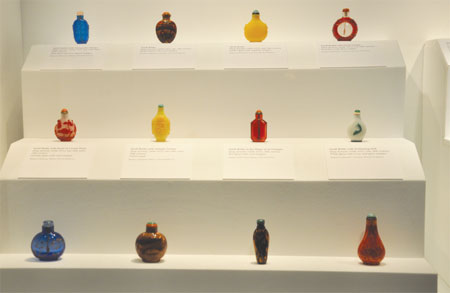Snuff bottle 'gems' on display at Met
Updated: 2013-10-25 10:07
By Kelly Chung Dawson in New York (China Daily USA)
|
||||||||
|
Around 80 Chinese snuff bottles are now on display at the Metropolitan Museum of Art in New York. Kelly Chung Dawson / China Daily |
In the late 17th century, European merchants and envoys introduced China to the aromatic ground tobacco mixture we now know as snuff. First a privilege of the imperial court and its officials, the use of snuff for its stimulating effects eventually became a habit practiced at every level of society. In a varied collection that includes pieces worth millions of dollars, New York's Metropolitan Museum of Art is now showcasing the art form of the snuff bottle, a uniquely Chinese innovation with European roots.
Small Delights: Chinese Snuff Bottles presents approximately 80 bottles in several media — porcelain, ivory, lacquer, metal and stone — measuring a few inches long and often intricately embellished with painting and calligraphy. Spanning the Kangxi (1662-1722), Yongzheng (1723-35), Qianlong (1736-95) and Jiaqing (1796-1820) dynasties, the pieces demonstrate the creativity of both Chinese and European craftsmen producing for the Chinese market.
Prior to its introduction into China, snuff was typically stored in small boxes. Chinese craftsmen soon devised a more efficient airtight bottle for the local climate, where snuff was prone to dry out. Their craft already had precedent in the bottles used in traditional Chinese medicine, but the commission of artistically rendered containers for the powder elevated the functionality of the tiny vessels to an art.
"These small items were enormous status symbols and a reflection of the frequent contact between China and the West," said Jason Sun, curator of Asian art at the Metropolitan Museum. "Chinese bottles were influenced by Western art, but became distinctly Chinese personal adornments, showing your taste and style in a statement that you could afford expensive things. Owning an expensive piece was like driving a Mercedes."
Often carried in a small satchel with tassels or specially made pockets, the pieces were alternately used as domestic adornments or public statements.
During his reign from 1662 to 1722, the Kangxi emperor established an imperial workshop in which ateliers created elegant containers first used as gifts for visiting dignitaries, officials and friends. Those early pieces experimented with glass, metal and enamel under the supervision of European craftsmen. Many of the pieces in Small Delights show evidence of that European influence, in particular one modeled after the shape and design of a Spanish silver dollar.
Early artisans introduced the use of European enamel painting, exploring typically European motifs, including that of mother and child. Some created tiny baroque masterpieces in the European style, while others turned to traditional Chinese painting in tiny landscapes applied to glass pieces. One piece by the master Ye Zhongsan (1875-1945) depicts a man on horseback against the backdrop of a Chinese landscape.
As the use of snuff became more widespread, the bottles were often mass-produced for the lower-end markets, and the wide range of designs created a diverse art form rife for collectors today, Sun said.
Although the practical use of snuff bottles died out in the early 20th century around the time cigarettes became widely available, the containers can still be found all over China and remain an object of fascination, said John Ford, president of the International Chinese Snuff Bottle Society.
Small Delights was mounted at the suggestion of the ICSBS, which was founded in 1968. With roughly 450 members today, the group provides a forum for academic treatises and will host its 45th annual convention at New York's Waldorf Astoria from November 5-9. Featuring vendors, dealers and collectors displaying approximately 2,000 bottles, the five-day event will bring together just a sampling of a market that includes thousands of collectors worldwide, Ford said.
"Even if you know nothing about snuff bottles, visitors to the exhibit at the Met will surely be fascinated by the beauty of these precious, small gems," Ford said. "For those of us who collect, we feel that once you're infected with the passion for the pieces, you'll want more than one. They're beautifully made, elegant miniatures that have been exquisitely crafted. They're truly gems."
Contact the writer at kdawson@chinadailyusa.com

 Post-baby Duchess
Post-baby Duchess
 Victoria Beckham S/S 2014 presented during NYFW
Victoria Beckham S/S 2014 presented during NYFW
 'Despicable' minions upset Depp's 'Lone Ranger' at box office
'Despicable' minions upset Depp's 'Lone Ranger' at box office
 'Taken 2' grabs movie box office crown
'Taken 2' grabs movie box office crown
 Rihanna's 'Diamonds' tops UK pop chart
Rihanna's 'Diamonds' tops UK pop chart
 Fans get look at vintage Rolling Stones
Fans get look at vintage Rolling Stones
 Celebrities attend Power of Women event
Celebrities attend Power of Women event
 Ang Lee breaks 'every rule' to make unlikely new Life of Pi film
Ang Lee breaks 'every rule' to make unlikely new Life of Pi film
Most Viewed
Editor's Picks

|

|

|

|

|

|
Today's Top News
US, China broadband companies join forces
Chinatown restaurants learn how to get an 'A'
Snuff bottle 'gems' on display at Met
Beijing airport set to become world's busiest
US firms urge easier process for investment
Wal-Mart plans to open 110 new stores
Spy claims stir rebuke to Obama
China calls for strengthened EU ties
US Weekly

|

|








